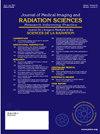A critical analysis of personal radiation protection in the catheterization laboratory: A systematic review
IF 1.3
Q3 RADIOLOGY, NUCLEAR MEDICINE & MEDICAL IMAGING
Journal of Medical Imaging and Radiation Sciences
Pub Date : 2024-10-01
DOI:10.1016/j.jmir.2024.101534
引用次数: 0
Abstract
Background / Purpose
Over the last decade, there has been a growing body of evidence on the adverse health effects of occupational exposure to ionizing radiation from fluoroscopically guided procedures, including left-sided brain tumors, skin cancer, posterior subcapsular lens changes, and thyroid disease. It is assumed that traditional radiation protection equipment provides adequate protection from exposure to scattered radiation. However, a growing body of evidence casts doubt on whether cath lab personnel exposed to ionizing radiation are being adequately protected.
Methods
A systematic literature review was used to identify, select, and critically appraise research to determine the efficacy of personal protection equipment currently worn in the catheterization lab. The literature reviewed was collected from the following databases: CINAHL, PubMed, Science Direct, and Medline. The search was limited to full-text and scholarly journals published between 2013 and 2023 in the English language. Articles were selected for inclusion based on relevance. The literature search for this systematic review was performed using the Preferred Reporting Items for Systematic Reviews and Meta-analyses reporting guidelines.
Results
The recurring theme in this literature review is that the orientation of the body to the source of radiation scatter appears to be critical and significantly reduces the effectiveness of personal radiation protection equipment in the cath lab.
Conclusion
The orientation of personnel who perform fluoroscopically guided procedures towards the source of scatter exposes them significantly to radiation. Traditional personal radiation protection aprons and equipment frequently provide inadequate shielding in the cath lab environment. Considering the increasing evidence highlighting the occupational risks associated with fluoroscopy, it is crucial to reassess personal radiation protection to ensure the safety and well-being of interventional teams responsible for life and limb saving procedures.
导管室个人辐射防护的批判性分析:系统回顾
背景/目的在过去的十年中,越来越多的证据表明,职业性暴露于荧光引导程序产生的电离辐射会对健康造成不良影响,包括左侧脑肿瘤、皮肤癌、后囊下晶状体病变和甲状腺疾病。一般认为,传统的辐射防护设备可以提供足够的保护,避免受到散射辐射的照射。然而,越来越多的证据让人怀疑暴露在电离辐射中的阴道实验室人员是否得到了充分的保护。方法通过系统性文献回顾来识别、选择和批判性评估相关研究,以确定目前在导管室佩戴的个人防护设备的有效性。所查阅的文献来自以下数据库:CINAHL、PubMed、Science Direct 和 Medline。搜索范围仅限于 2013 年至 2023 年间出版的英文学术期刊全文。根据相关性选择纳入的文章。本系统综述的文献检索采用了《系统综述和荟萃分析首选报告项目》报告指南。结果本文献综述中反复出现的主题是,身体朝向辐射散射源的方向似乎至关重要,这大大降低了个人辐射防护设备在阴道实验室中的有效性。传统的个人辐射防护围裙和设备在阴道实验室环境中往往不能提供足够的屏蔽。考虑到越来越多的证据表明透视检查存在职业风险,重新评估个人辐射防护以确保负责挽救生命和肢体的介入团队的安全和健康至关重要。
本文章由计算机程序翻译,如有差异,请以英文原文为准。
求助全文
约1分钟内获得全文
求助全文
来源期刊

Journal of Medical Imaging and Radiation Sciences
RADIOLOGY, NUCLEAR MEDICINE & MEDICAL IMAGING-
CiteScore
2.30
自引率
11.10%
发文量
231
审稿时长
53 days
期刊介绍:
Journal of Medical Imaging and Radiation Sciences is the official peer-reviewed journal of the Canadian Association of Medical Radiation Technologists. This journal is published four times a year and is circulated to approximately 11,000 medical radiation technologists, libraries and radiology departments throughout Canada, the United States and overseas. The Journal publishes articles on recent research, new technology and techniques, professional practices, technologists viewpoints as well as relevant book reviews.
 求助内容:
求助内容: 应助结果提醒方式:
应助结果提醒方式:


